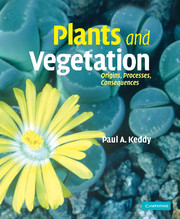Book contents
- Frontmatter
- Contents
- Preface
- Acknowledgements
- Chapter 1 Plants and the origin of the biosphere
- Chapter 2 Description of vegetation: the search for global patterns
- Chapter 3 Resources
- Chapter 4 Stress
- Chapter 5 Competition
- Chapter 6 Disturbance
- Chapter 7 Herbivory
- Chapter 8 Positive interactions: mutualism, commensalism, and symbiosis
- Chapter 9 Time
- Chapter 10 Gradients and plant communities: description at local scales
- Chapter 11 Diversity
- Chapter 12 Conservation and management
- Questions for Review
- References
- Index
- References
Chapter 7 - Herbivory
- Frontmatter
- Contents
- Preface
- Acknowledgements
- Chapter 1 Plants and the origin of the biosphere
- Chapter 2 Description of vegetation: the search for global patterns
- Chapter 3 Resources
- Chapter 4 Stress
- Chapter 5 Competition
- Chapter 6 Disturbance
- Chapter 7 Herbivory
- Chapter 8 Positive interactions: mutualism, commensalism, and symbiosis
- Chapter 9 Time
- Chapter 10 Gradients and plant communities: description at local scales
- Chapter 11 Diversity
- Chapter 12 Conservation and management
- Questions for Review
- References
- Index
- References
Summary
Herbivory as a disturbance. Field studies of herbivory. African mammals. Insects in rain forest canopies. Tortoises on islands. Sheep and slugs in moorlands. Morphological defences. Squirrels and cones. Chemical defenses. Nitrogen and food quality. Coevolution of fruits and herbivores. Exclosure experiments. Herbivorous insects in forests. Land crabs in tropical forest. Mammals in grasslands. Rhinoceroses in floodplain forest. Deer in forests. Small mammals in marshes. Bottom-up or top-down? Modeling the effects of herbivory.
Introduction
Growth and reproduction add biomass to plant communities. Disturbances remove biomass. Thus the amount of vegetation in an area will be controlled by the balance between the former (primary production) and the latter. Disturbances can be either abiotic (fire, flooding, landslides) or biotic (herbivory, burrowing, trampling). Herbivory is of particular interest as a disturbance because it is biotic and often selective, and the relationships between plants and herbivores are continually evolving.
It is important that one be aware that the study of herbivory, or plant-herbivore interactions, is made difficult by the many possible ways, both direct and indirect, by which herbivores can influence plants. Further, the relationship is not merely one-way because plants simultaneously influence herbivores. The study of plant–herbivore interactions has led to topics as wide ranging as animal nutrition, the evolution of teeth and guts, kinds of plant defenses, the physiological responses of plants to losing leaves or seeds, and the impacts of herbivores upon soils. Figure 7.1 outlines some of the possible interactions between plants and herbivores.
- Type
- Chapter
- Information
- Plants and VegetationOrigins, Processes, Consequences, pp. 284 - 335Publisher: Cambridge University PressPrint publication year: 2007



